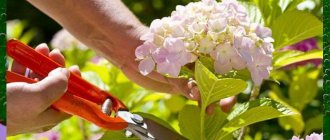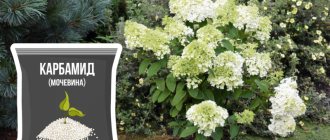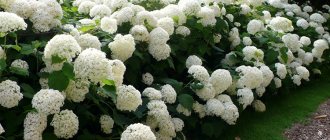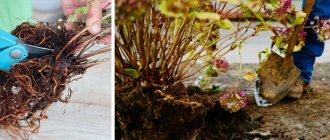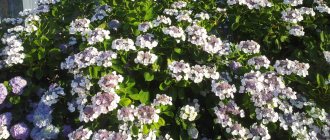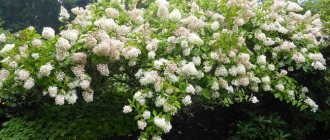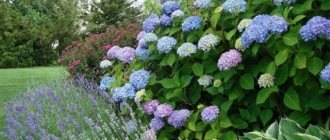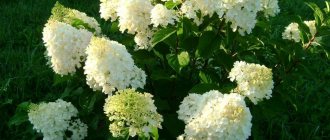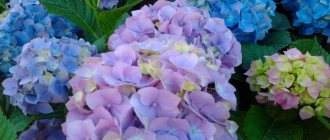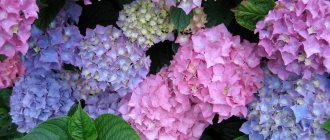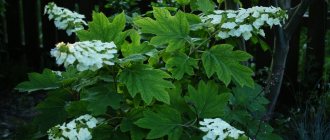Hydrangea can rightfully be called the queen of the garden. It blooms amazingly beautifully and is good both on the bush and as a cut flower. But in order for the bushes to look healthy and bloom profusely, they require regular care. One of the important stages of care is the application of fertilizers, which provide the hydrangea with nutrients. In addition to traditional organic fertilizers and complex mineral fertilizers, there are also folk recipes that have been tested in practice by experienced gardeners and are guaranteed to work. Feeding hydrangea with kefir? Easily. It is these unconventional feedings that we will talk about in this article.
It is important to know that any root feeding should be carried out after preliminary watering of the hydrangea; fertilizers should not be poured into dry soil. This rule applies not only to the fertilizers described in the article, but also to any other organic or mineral fertilizers applied in liquid form.
Feeding hydrangea with kefir and other fermented milk products
To prepare a solution for feeding hydrangea in autumn and spring, kefir, fermented baked milk, yogurt or whey are suitable. The bacteria contained in fermented milk products are beneficial not only to people, but also to plants, as they enrich them with important amino acids and improve immunity.
Dilute a liter of any fermented milk product in five liters of water, and then pour the hydrangea at the root. You can also carry out foliar feeding, but for this you need to prepare a less concentrated solution (0.5 liters of fermented milk product per 10 liters of water). Spray the hydrangea with the resulting solution.
Consequences of deficiency and excess of fertilizers
Nutrient deficiency is determined by external signs. How does hydrangea change when there is a shortage of fertilizers:
- nitrogen - weak, slow growing plant with yellow leaves;
- potassium - dark spots on the leaves, yellow drying border;
- phosphorus - leaves turn purple;
- iron - leaf chlorosis, color change to pale yellow;
- soil acidity - chlorosis.
Urgently select and apply the necessary fertilizer for hydrangeas within reasonable limits. Excess in this case is unacceptable.
Important! To avoid problems with growing hydrangea, organic or mineral preparations are administered only when absolutely necessary.
What does excess chemical fertilizers lead to:
- nitrogen - reduces frost resistance. Hydrangea will not be able to bloom, since all reserves are used to grow the crown;
- potassium - to early yellowing of leaves, loss of decorativeness of inflorescences;
- phosphorus - to poor absorption of microelements, increased sensitivity to drought;
- calcium - blocks the absorption of potassium and magnesium.
Growing hydrangea in the garden
And only through preliminary watering will it be possible to normalize the level of microelements and make the plant grow properly.
Note! Feeding paniculate hydrangea is regulated by seasonal needs for nutrients and promotes its beauty and health. Therefore, when applying fertilizers, the season, the stage of development of the bushes, the composition of the soil and its acidity are taken into account.
What to feed hydrangeas depends on your goals. The florist himself will decide which fertilizers are suitable in a particular case. But systematic feeding is necessary. Only in this case will the appearance of the plant be pleasing to the eye, the hydrangea will not get sick, will successfully survive the winter and will meet spring in good condition.
Potassium permanganate as a top dressing
It's no secret that potassium permanganate solution is used to disinfect soil and planting material. This solution effectively helps eliminate germs and pathogenic bacteria. In addition, the oxygen contained in this compound nourishes the root system, and potassium strengthens the branches of hydrangea and makes them less brittle and more flexible.
To carry out root feeding, you need to prepare a weak light pink solution; for each adult bush you will need a ten-liter bucket of such a solution. In the spring, when the plant comes out of dormancy, you can carry out foliar feeding and spray the hydrangea branches with this solution.
How to feed hydrangea in spring
Awakening from winter sleep for a plant is due to the active growth of green mass. Nitrogen is responsible for the growth of foliage, shoot growth and bud formation. As part of the spring fertilizer for hydrangea, it plays a central role.
Spring feeding of the plant is carried out when the soil has dried and the hydrangea leaves have blossomed. Prepare a mixture of:
- urea,
- potassium sulfate.
A matchbox of each type of fertilizer is filled with a bucket of water. For each adult bush, use half a bucket, watering the bush at the root.
Important! Root feeding of plants is carried out only on moist soil! Otherwise, you can burn the roots.
In early spring, hydrangea can be fed:
- mullein infusion (1 part manure to 10 parts water),
- chicken droppings (1 part fertilizer and 14 parts water).
The solution is prepared by pouring manure or droppings with water. The mixture is infused for a day. The consumption rate is 5 liters per adult plant, 1-2 liters are enough for young seedlings.
Tree hydrangea and grandiflora hydrangea respond especially well to this feeding.
Experienced gardeners often use Pokon fertilizer for rhododendrons and azaleas. Nitrogen and potassium occupy the main part of the fertilizing composition. This is a long-lasting fertilizer that can be simply scattered under the bushes in the spring; its effect on the plant will not weaken until autumn.
The current fertilizer for spring feeding of hydrangea is the Russian fertilizer “Flower Paradise”. In addition to accelerating the growth of foliage and increasing the number of buds, the drug strengthens the plant’s immunity and protects it from the negative effects of frost.
During budding, compositions containing potassium and phosphorus are prepared for hydrangea. This can be superphosphate, in an amount of 20 g per 10 liters of water; or ready-made mineral fertilizer with a predominance of the necessary substances (Agricola, Kristalon).
To give flexibility to the shoots of ornamental shrubs, the plant is sprayed with a pink solution of potassium permanganate three times in the spring. Treatment with potassium permanganate will protect hydrangea from a number of fungal diseases.
If the leaves turn yellow
Hydrangea often emerges from winter sleep weakened, its leaves grow poorly, their leaves turn yellow and become smaller. The most common cause of this plant condition is a lack of nitrogen. An “ambulance” for the bush will be spraying the hydrangea crown with ammonia. Ammonia is an ammonia solution, that is, a nitrogen fertilizer. 2 tablespoons of ammonia are added to a bucket of clean water and the bush is sprayed from top to bottom. 1 – 2 treatments of the plant are enough.
Another reason for yellowing of hydrangea leaves may be a disease called chlorosis. The plant is treated by treating the leaves with iron sulfate and iron sulfate - 5 g of powder per 1 liter of water.
Feeding hydrangea with citric acid and vinegar
Hydrangea is one of the few plants that prefers soil with a high level of acidity; in such soil it feels most comfortable and blooms well. To increase the acidity of the soil, you can use food products such as citric acid or apple cider vinegar. Such fertilizing can be carried out throughout the season with an interval of 20-25 days.
To prepare a solution of apple cider vinegar, you will need to dilute 100 g of the product in a bucket of water. To prepare a solution of citric acid, first dissolve two tablespoons of the substance in 1 liter of water, and then increase the volume to 10 liters.
What to do before applying fertilizers
Hydrangea will not be able to properly absorb fertilizer if the soil is not ready. Before feeding, the flower is watered at the root. Instead of abundant watering with plain water, an acidic environment is created. Acidified water is poured into pre-prepared grooves.
How to feed hydrangea in spring for lush flowering in the garden
Compositions for soil acidification:
- per bucket of water 2 tbsp. spoons of citric acid;
- for 10 liters of water 2 glasses of sour dry homemade wine;
- 1 cup of apple cider vinegar per bucket.
The procedure is carried out in the morning, and fertilizing is applied in the evening. Since mineral fertilizers are added to small trenches around the bush, they are prepared in advance.
Note! Do not get carried away with excessive acidification of the soil. The ideal soil acidity for hydrangea growth is 6.5. At a higher pH value, iron deficiency and chlorosis of bushes are possible.
Rusks and yeast as top dressing
An unusual top dressing can also be prepared from dried bread. A third of a bucket of crackers and two thirds of crushed weeds should be filled with water, closed and left for seven days. During this period, the fertilizer should ferment. Then the infusion should be filtered (the grounds can be sent to the compost heap) and the resulting concentrate should be diluted with five parts of water. This fertilizer contains everything you need for the full growth and flowering of hydrangea.
Instead of bread crumbs, you can use fresh yeast; for this, dissolve one hundred grams of the product and a spoonful of sugar in ten liters of water and leave for 24 hours. During this time, the solution will begin to ferment, and it will be possible to water the hydrangeas with it. Each bush will require 5 liters of nutrient solution.
When to feed hydrangea: timing and fertilizer application schedule
According to the generally accepted scheme, the flower is fertilized during the following periods.
In spring for active growth
How to feed geranium - means for abundant flowering and growth
During this period, hydrangea needs nitrogen. They use saltpeter, urea, ammonium sulfate and other similar drugs. From about April 9 to April 21, to increase green mass and form beautiful leaves, the bushes are fed with the following composition: dissolve 20 g of urea and the same amount of potassium sulfate in a bucket of water. Apply up to 5 liters of solution under a garden plant.
Note! From April 1 to May 30, to ensure the flexibility of the stems, you need to repeatedly water the bushes with a solution of potassium permanganate.
In summer during budding
During the period of bud formation and flower appearance, the soil is fertilized with mineral compounds - phosphorus and calcium. Complex fertilizers are applied, and organic matter is added in mid-summer.
How to feed hydrangea in June. From June 5 to June 17, fertilize with superphosphate, potassium, and introduce complex fertilizers. In July, organic matter is alternated with complex compounds, and from August 4 to August 29, the soil is acidified with lactic acid.
Feeding during budding
In autumn to prepare for wintering
Wintering of hydrangea and future flowering depend on autumn feeding.
How to water hydrangea to set flower stalks? From September 3 to 15, water with potassium-phosphorus and magnesium-boron compounds without adding nitrogen. Before hibernation, feed with the following fertilizer: dilute 20 g of sulfuric acid powder and the same amount of a preparation containing superphosphate in a bucket of warm water.
Important! In winter, the culture is not disturbed.
Hydrangea (Hydrangea)
Hydrangea is a perennial shrub; its height can reach 1-1.5 m. The leaves of the plant are oval, ovate with sharp serrated edges. The length of the leaves rarely exceeds 14-16 cm. They are located parallel to each other on the stem. Flowers combine many shades of white, pink, blue (safe mineral supplements help change the intensity). Small inflorescences are collected in large umbrellas that reach a diameter of 35 cm.
But the bush needs regular and proper care, including feeding with fertilizers. The opinions of gardeners may differ, but basically they agree: the plant must be fed at least 2 times a year for abundant flowering.
The need to introduce nutrients in the off-season depends on the type of fertilizer used at the stage of the beginning of bud formation, as well as on the method of care in the autumn-winter period.
Fact! Gardeners love hydrangea for its attractive brightness and high resistance to diseases and pests.
Peculiarities
In many gardens in central Russia you can find a plant blooming luxuriantly with white flowers collected in panicles. Due to the peculiarities of its structure, this bush is called paniculata hydrangea, which differs from other representatives of its genus in its size and design features. This culture came from China, Japan, Sakhalin and the Far East and over time spread far beyond these regions.
Hydrangea feels good under different climatic conditions, so the presence of cold weather in winter does not affect it in any way. The bush can live up to 60 years, withstanding frosts of 25 degrees. Despite the high rates of resistance to environmental phenomena, for full growth and development, as well as decorative flowering, a number of rules must be followed.
- It is better to plant bushes in partial shade. When the hydrangea is constantly exposed to sunlight, the flowers lose their decorative effect.
- It is best to plant the plant in fertile, clayey, acidic and moist soil. In the absence of proper conditions, it is worth creating them on your own.
- Planting a bush in the ground depends on the region. In warm climates this is spring and autumn, and in temperate climates spring is considered the best time.
- When planning a site for hydrangea, it is worth digging holes at a distance of 1-2 meters, no closer, so that the bushes feel good when they grow.
- For full growth of hydrangea, it is necessary to regularly loosen the soil around the bush, weed the weeds, water well, prune on time and correctly, and also fertilize.
Features of fertilization
Due to the fact that hydrangea needs frequent and abundant watering, useful substances that need to be replenished are intensively washed out of the soil. Feeding paniculata hydrangeas will make it possible to strengthen the bush, improve its decorative qualities, and extend the flowering period. If you do not apply fertilizer in time, the plant will become weak, the color of the leaves and flowers will be duller, and any diseases and pests will become a big problem for the bush.
To understand what exactly hydrangea needs, you should study it carefully:
- with a dry border on the leaves, a lack of potassium can be noted;
- with obvious chlorosis of the leaves, a lack of proper iron levels can be identified;
- when the surface of the leaf blade turns yellow, you can see a lack of nitrogen;
- when the shade of the leaves changes and they acquire a purple tone, the absence of phosphorus can be noted.
For lush flowering of hydrangea, it is recommended to fertilize it with a pale pink solution of potassium permanganate, which will help strengthen the tissue structure. Such care should be carried out no more than once a month. In addition to the general requirements, there are specific preparations that are applied under the bush at a certain time.
Mineral complex mixtures - how to choose
If organic matter can be used once every 2–3 years, then mineral complex mixtures will come in handy annually. The principle of their use is as follows:
You can feed hydrangeas in the spring with mixtures with a higher nitrogen content. This helps to grow leaves, shoots, and strengthens the immune system. There are special fertilizers for hydrangeas for different growing season cycles - spring, summer, autumn.
Before flowering, you should switch to a potassium-phosphorus diet 2 weeks before flowering. These are the elements that will be consumed in large quantities during the month of flowering hydrangeas. Nitrogen is needed in small quantities, but is still needed.
After flowering, only potassium and phosphorus are used as fertilizing for hydrangeas. Of all the available types, acidified ones are chosen - superphosphate and potassium sulfate.
The dosages are stated in the instructions for each drug - the instructions should be followed. Excessive amounts of fertilizer have a depressing effect on the condition of plants.
Video: How to fertilize hydrangea before flowering
The role of potassium in flowering
Potassium is called the main component of flowering, without which ornamental garden species look dull - both greenery and flowers. Potassium is the most consumable element, so it needs to be added every year - before flowering and in the fall to restore the buds.
Potassium deficiency in hydrangeas can be determined by drying old leaves - marginal burn. In order for flower stalks to form seeds and the plant to survive, there is an outflow of potassium to young leaves and shoots. The old ones die off.
Potassium must be added along with phosphorus so that metabolic processes proceed smoothly. If there is a phosphorus deficiency, potassium will be poorly absorbed. The same thing with nitrogen: there is no phosphorus - the leaves turn yellow. Inexperienced gardeners may have a misunderstanding of the situation.
Phosphorus as a binding component of all fertilizers
Lack of phosphates negatively affects metabolic processes. Deficiency can be identified by bluish leaves that take on a purple hue.
Fertilizing with phosphorus for hydrangea can be applied once per season. This macroelement dissolves gradually and does not go into the deep layers of the soil, so it is always available.
The best option is superphosphate. This fertilizer is poured with hot water, since it takes a long time to dissolve in cold water. The optimal time for application is spring, but it is advisable to feed the plants with phosphorus also in the fall so that the crops form buds.
Microelements - what they need for hydrangeas
Plants consume microelements in small quantities, but they must be present in fertilizing. The full set can only be found in organic fertilizers. If you use mineral ones, you need special concentrates, which are diluted and watered at the root of hydrangeas.
Iron is important. Its deficiency affects the intensity of the green color of the leaves.
Gardeners sometimes think that the plant lacks nitrogen, but adding urea does not solve the problem - the plant withers even more, as saturation with nitrogen occurs.
Iron deficiency most often occurs in areas with neutral or alkaline soil composition. If a lot of organic matter is added, for example, ash, hydrangeas will not be able to absorb iron and will turn yellow.
For feeding, it is best to use iron supplements in chelated form. The microelement is, as it were, sealed in an organic shell - plants absorb such fertilizers first.
To improve immunity, copper is added. Copper sulfate is suitable for this, but in a reduced concentration. This also helps protect hydrangeas from fungus and pests.
Get rid of weeds in your summer cottage forever! Advanced development of Russian agronomists. All information is here
Deadlines
Each feeding has its own specific time. This is due to the fact that different elements contained in additives are responsible for different life processes of hydrangea. And also, when receiving all the necessary substances, hydrangea will be more resistant to changing weather conditions, diseases, pests and other stresses (for example, transplantation). Before feeding the plant, you need to remember whether you added any fertilizer to the hole when planting the plant. If yes, then the hydrangea will not need additional feeding for the next couple of years.
In the spring, it is necessary to feed the plant with those microelements that are needed for the active growth phase. These include: nitrogen, phosphorus, potassium, magnesium, iron. Nitrogen is responsible for the set of vegetative mass. A lack of phosphorus will result in weak and inexpressive flowering. Potassium is a universal element that can be added to complementary foods in both spring and autumn. In spring feeding, it is responsible for high-quality flowering. The brightness of inflorescences and the formation of buds depend on magnesium.
Popular articles Saffron: aroma and taste
The first feeding of the plant occurs when the snow melts and the first grass shoots appear. This usually occurs in May or late April. The first feeding should consist of nitrogen-containing fertilizers. This is ammonium nitrate or urea. If desired, you can use organic fertilizers, but their effectiveness is much lower. Potassium and phosphorus can be used along with nitrogen supplements.
It happens that you forgot or missed the first feeding. There is nothing wrong with this, the main thing is to add a little more nitrogen during the second feeding. If you missed the second feeding, this is also no reason to be upset. Some gardeners do not feed hydrangeas at all and, despite this, they grow well. You should not completely exclude nitrogen from fertilizing - it is what helps the plant form new stems and leaves.
The second feeding should be in July, during the budding period. Most often, most gardeners do only one fertilizing - just when the buds are forming. They immediately provide the plant with a full range of essential nutrients and microelements. However, the main thing here is not to overdo it, so such things should be left to more experienced gardeners.
During the second feeding, the emphasis, on the contrary, shifts towards phosphorus and potassium, as they affect the condition of the buds. Very little nitrogen is required to maintain the overall appearance of the plant. Excess nitrogen can cause the vegetative mass to absorb most of the nutrients, preventing the buds from properly forming and opening. And also an excessive amount of nitrogen will lead to the fact that the hydrangea will simply begin to “drive the foliage”, not allowing the leaves to fully live out their life cycle, forming new ones all the time. As a result, the leaves will become weaker and the plant itself will begin to wither.
The very last feeding occurs in the fall to prepare the hydrangea for the long wintering period. Its goal is to allow the plant to accumulate as many nutrients as possible so that next year the awakening and formation of new buds occurs as soon as possible. In this regard, potassium comes first, followed by phosphorus. We begin to gradually remove nitrogen from fertilizing immediately from the beginning of August and completely remove it from the composition by the fall, since it is responsible for the formation of new branches, which is absolutely not useful in winter. Conversely, the amount of potassium increases, since it is responsible for the formation of a strong root system, and the stronger and longer the roots of the plant, the better the plant will survive the winter, when the amount of nutrients in the soil is minimal.
